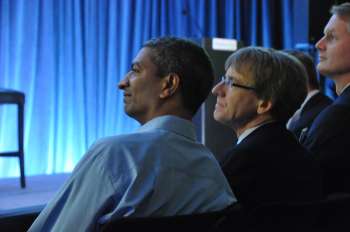The U.S. Senate is unlikely to pass a comprehensive climate change bill to reduce greenhouse gas emissions this year, according to a Reuters survey of 12 key Democrat and Republican Senators who could hold the swing votes.
While
the Obama administration and a bipartisan core of senators still hope there is life for a climate change bill that would put a price on carbon emissions and help reinvigorate ailing international talks, the senators interviewed by Reuters this week were much more pessimistic.
The survey underscores that global warming--a scientific finding still hotly disputed by many Americans--could end up being set aside by politicians focusing on issues that hold more appeal to voters ahead of congressional elections in November.
"The economy has got to be given a major boost, particularly when it comes to jobs. I think that's going to be our focus," said senior Democratic Senator Carl Levin. His home state of Michigan is suffering from high unemployment and manufacturers there fear the higher energy prices a climate bill would bring could make things even worse.
"And if we can do something on health care this year, those two things are going to use up most of the oxygen. So it's hard for me to see how we get to the climate issue," Levin said.
If the Senate fails this year to pass a bill reducing domestic carbon dioxide pollution, which is blamed for global warming, it would be a further blow to global negotiators seeking to cobble together a successor to the Kyoto Protocol.
It also would put the U.S. Environmental Protection Agency in charge, at least for the time being, of forcing such pollution controls. But even EPA this week notified Congress it would move somewhat more slowly with regulations and only against the big polluters.
As Congress returned to Washington from a week-long recess, Reuters queried 16 of the 100 senators this week, most of whom had not yet announced whether they would support or oppose specific climate legislation. As swing votes, they would be the focus of any upcoming Senate fight to pass a bill.
Republican Richard Lugar of Indiana "doesn't think the climate bill will pass this year," a spokesman for the senator said. "I believe it is highly unlikely the Senate will pass a climate bill this year...it will be especially hard given the fragile state of the economy," said fellow Republican George Voinovich of Ohio.
Dynamic still could change
The sober assessment comes despite the latest effort to forge consensus by a trio of senators across the spectrum--Democrat John Kerry, Republican Lindsey Graham, and independent Joseph Lieberman--and after President Barack Obama offered additional measures to entice Republicans, including federal loan guarantees to help pay for more power plants.
After months of work, the senators still haven't produced a bill they think can win broad support, although they say one will be unveiled soon. The House of Representatives passed a bill that included a contentious cap-and-trade mechanism last June, surprising many who thought a consensus could not be reached.
Kerry, admitting he was bucking "conventional wisdom," said that a compromise bill "can change the debate."
Lugar, Voinovich, and Levin were among a dozen of the 16 senators surveyed who see little hope for legislation to cap and then slowly cut U.S. greenhouse gas emissions linked to global warming and require power plants, oil refineries, and other sectors of the economy to have pollution permits.
The Senate's rules that usually require 60 votes to pass controversial legislation such as climate change also present a major hurdle.
However, while lawmakers see little hope of the Senate approving a climate change bill this year, they are more optimistic about a stand-alone energy bill that would expand offshore drilling, support building more nuclear power plants, and require a portion of U.S. electricity supplies to be generated by renewable energy sources like wind and solar power. A Senate panel already has approved such a bill.
"It takes so many votes to get something through and I think there's more unity on energy than there is on climate change when it comes to this body," said Democrat Ben Nelson from Nebraska.
Lawmakers are responding not only to the political realities, but to their constituents, who are showing diminishing concern about global warming.
The proportion of people who believe global warming is probably a hoax more than doubled since 2008 to 16 percent of the American public, according to a survey released this week by researchers at Yale and George Mason universities.
Those who are most certain that global warming is happening and caused by humans has fallen to 10 percent from 18 percent.
"Gloomy unemployment numbers, public frustration with Washington,
attacks on climate science and mobilized opposition to national climate legislation represent a 'perfect storm' of events that have diminished public concerns about global warming--even among the alarmed," said Anthony Leiserowitz, director of the Yale Project on Climate Change.
Even long-time supporters of legislation to fight global warming, like Democrat Dianne Feinstein from California, appear to be throwing in the towel for this year.
"I do want a climate bill," said Feinstein. But when pressed further on whether the Senate would likely pass a bill this year, she admitted: "No, but we should."
Story Copyright (c) 2010 Reuters Limited. All rights reserved.
Source: news.cnet.com



































